Defending against disease
Adopting an integrated management plan can enhance plant health and defend against diseases, explains Geoff Fenn and Kelly Clack from Origin Amenity Research & Development Centre.
Microdochium Patch occurs when the pathogen, a susceptible host grass and favourable environmental conditions interact. Disease occurrence and intensity are affected by the duration that the three primary factors are aligned. Disease will develop when environmental conditions that favour the disease triumph.
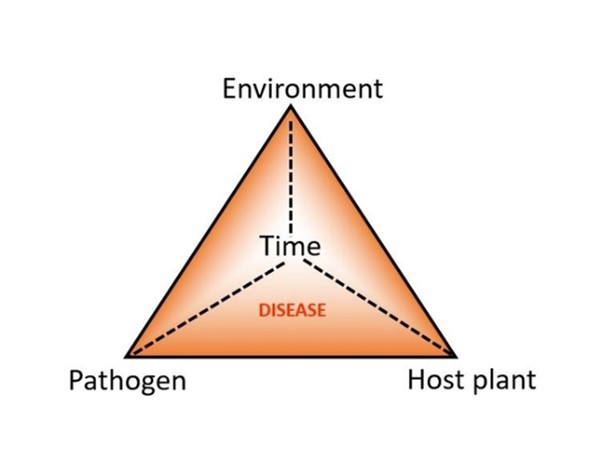
Integrated management plans can be utilised to enhance plant health and plants defences as well as altering the environmental conditions to favour the turfgrass and discourage the pathogen. Water management plays a key role in cultural disease control; adequate drainage, thatch management, aeration, improved airflow and shade reduction on surfaces is essential. Dew and guttation fluid should be removed to reduce periods of leaf wetness; the use of dew dispersants at times of prolonged leaf wetness (continuous fog or light drizzle in mild, humid conditions) will support your physical management practices. We should also consider other cultural disease controls such as grass species, sward density, mowing height and frequency, soil temperature and soil fertility as they can be in favour of, or against, a pathogen.
Fertilisers with an acidic pH will reduce the chance of Microdochium Patch, as an acidic surface is less favourable to the pathogen. Consideration should also be given to the quantity of nitrogen being applied as well as the soil temperature and the nitrogen source used. The plant should be healthy and recovering from play without a great increase in clip rate. Lush growth could leave the turf more susceptible to disease.
Plant elicitors can be beneficial before and during periods of disease risk. Elicitors stimulate the plants’ natural defences (they trigger a defence response) and elicit phytoalexins that gather around the site of infection to resist the pathogen attack. Examples of plant elicitors are phosphite, salicylic acid and harpins.
With the above in mind, the aim is to create an environment that is unfavourable to the pathogen and to support a healthy plant that is primed to defend itself (systemic acquired resistance) against the pathogen, in this case Microdochium nivale. Trials have been carried out both at Origin’s Technology Centre and at the STRI in Bingley utilising acidifying agents, macro and micro-nutrients, biostimulants, and a variety of plant elicitors.
Trial key findings
• The plant elicitor mix was extremely effective in preventing disease. No disease at all was recorded on the treatments from September through to March. Up to 13 percent average disease content was recorded on control plots.
• Excellent control and visual merit were apparent even in areas where neighbouring plots were severely affected.
• Turf health was also measured via NDVI (Normalised Difference Vegetation Index) readings and the plant elicitor mix maintained superior turf health to control.
• Concurrent trials run at STRI in Bingley also gave significant improvement over control plots.
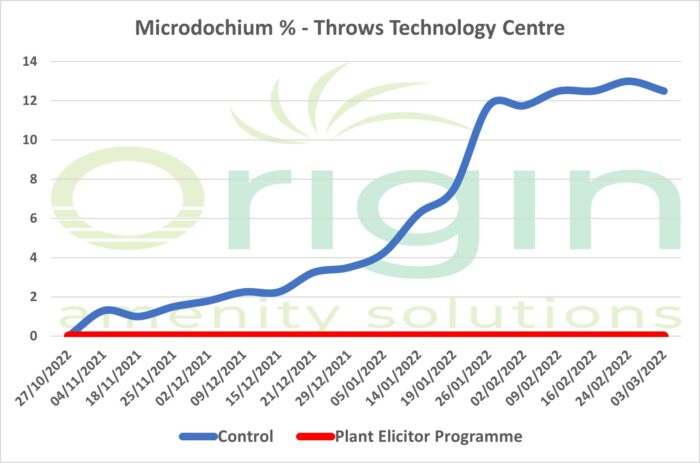
The Plant Elicitor programme kept plots disease-free all autumn and winter
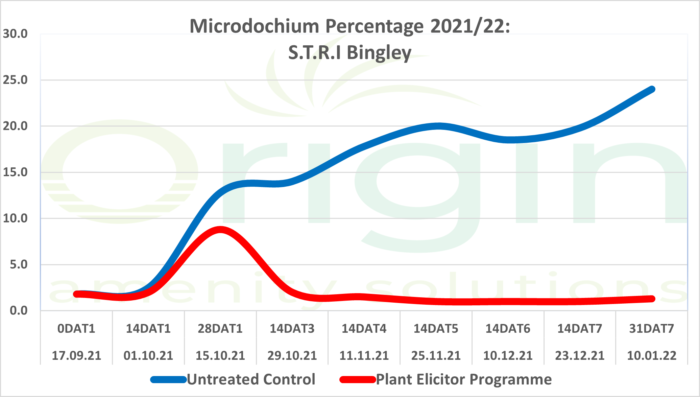
Despite the trial beginning with disease already present, good control was achieved
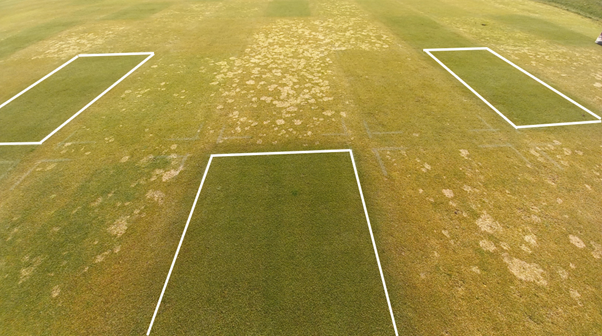
Plant Elicitor plots at Throws Technology Centre showing disease resistance without fungicides
These trials show that the plant elicitor programme shows good efficacy on very different sites in both south and north England with very different microclimates. It also illustrates how important it is to be proactive with your programme to prevent disease. By getting applications down while the turf was still healthy at Throws we avoided the initial infection and disease scars that occurred at STRI when 1.8 percent disease was already visible when the first applications went down.
If you have a challenging site where it is difficult to implement critical cultural controls such as; thatch management, drainage, airflow and shade, plant protection products can be an essential part of your disease management strategies. An integrated management plan should be implemented in a preventative approach to reduce disease, giving thought to application timings. During a recent trial a growth potential model was adopted for pesticide applications.
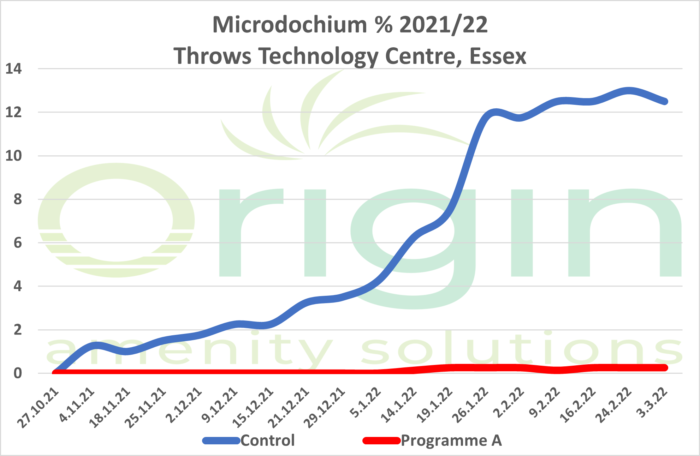
Fungicide programme results at Throws – excellent disease control
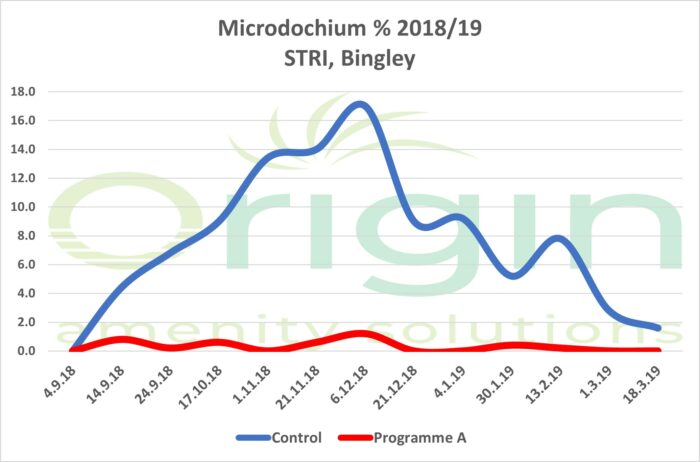
The same products achieved good control three years ago in independent trials
During our trial last autumn / winter we attempted to optimise fungicide applications by timing our re-application intervals based on growth of the plant rather than simply every three or four weeks. The reason for this was to ensure sufficient active ingredient was within the plant in order to suppress disease at all times without wasting product by spraying when not needed. In order to achieve this, we re-applied based on Growth Potential (GP). GP is a measure of the potential growth of the plant based on the average air temperatures taken from your local weather forecast or weather station. More information on calculating GP can be found by searching for Growth Potential calculators online.
The control we achieved using this method was extremely good – keeping disease below 0.5 percent throughout the trial. The programme of fungicides used was exactly the same as was trialled at STRI 3 years ago.
The key difference between these two trials was application intervals:
• The STRI trials were applied via the calendar – five applications were required;
• The Throws trials were applied via Growth Potential – four applications were required.
By utilising GP and optimising fungicide application timing, control was equally effective but one less application was required. We will be investigating GP intervals further in future trials to see if we can refine both control and fungicide applications even more.
Be considerate to environmental factors and weather forecasts to understand disease risk. The use of plant elicitors and reducing leaf wetness can be key factors when controlling Microdochium Patch. Consider integrated management plans as a preventative or priming of the turf before disease outbreak occurs.
Origin Amenity Solutions can be contacted on 0800 138 7222 or email sales@originamenity.com















Let me tell You a sad story ! There are no comments yet, but You can be first one to comment this article.
Write a comment